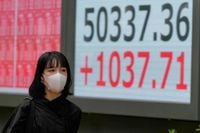Stocks on Wall Street soared to new heights on Monday, October 27, 2025, capping off a remarkable run that has defied expectations and left investors both elated and cautious. The S&P 500 rose 1.2% to close at 6,875.16, its first-ever finish above the 6,800 mark, while the Dow Jones Industrial Average gained 337.47 points, or 0.7%, to reach a record 47,544.59. The Nasdaq composite also jumped 1.9% to 23,637.46, with all three major indexes notching all-time highs for the second consecutive day, according to AP and CNN.
The rally wasn’t confined to U.S. borders. Asian markets surged as well, with Shanghai up 1.2%, Hong Kong rising 1%, Tokyo’s Nikkei 225 leaping 2.5%—crossing the 50,000 threshold for the first time—and South Korea’s Kospi climbing 2.6%. Tokyo’s gains reflected high public support for newly appointed Prime Minister Sanae Takaichi, whose market-friendly and defense-boosting policies have sent shares of defense contractors like Kawasaki Heavy Industries soaring 9% in a single day, AP reported.
This exuberance came as investors eyed a crucial week filled with events that could shape the market’s direction for months. The most anticipated is the meeting scheduled for Thursday, October 30, between U.S. President Donald Trump and Chinese leader Xi Jinping. Hopes are high that the talks might ease trade tensions that have simmered for years between the world’s two largest economies.
U.S. Treasury Secretary Scott Bessent, speaking from the ASEAN Summit in Kuala Lumpur, Malaysia, told reporters, “I think we have a very successful framework for the leaders to discuss on Thursday.” President Trump himself struck an optimistic tone, saying, “We feel good about working things out with China,” as quoted by CNBC.
The framework reportedly under discussion could include a delay to China’s rare earth export restrictions, the withdrawal of Trump’s threatened 100% tariffs on Chinese goods—set to begin November 1—and a resumption of Chinese purchases of American soybeans. There’s even talk of resolving the long-standing TikTok dispute, allowing for a U.S.-based version of the app. “I have a lot of respect for President Xi, and we are going to come away with the deal,” Trump said from Air Force One, according to CNBC.
Markets have been on a tear since April, with the S&P 500 up an eye-popping 38% from its springtime lows, when fears about tariffs and global trade wars were at their peak. Analysts say the rally rests on more than just hopes for a trade breakthrough. The Federal Reserve’s expected moves are front and center. The central bank is widely anticipated to announce another quarter-point interest rate cut on Wednesday, October 29—its second straight reduction. Traders are nearly unanimous in expecting the cut, bolstered by last week’s inflation report, which came in slightly cooler than economists had forecast.
“With the Fed likely to cut rates two more times this year, and with AI collaborations continuing, I think right now, we are trading on FOMO fumes,” said Sam Stovall, chief investment strategist at CFRA Research, in an email to CNN. “We’re running on adrenaline. Valuations are still stretched, but at least in the near term, things are still looking good.”
Lower interest rates have provided a tailwind for stocks, making borrowing cheaper and encouraging both consumer spending and corporate investment. However, the Fed has warned that if inflation accelerates beyond its already high level, it may need to change course—a risk that’s keeping some investors on edge.
Corporate earnings have also played a starring role in the rally. About 86% of S&P 500 companies that have reported third-quarter earnings so far have beaten expectations, according to FactSet data cited by CNN. Keurig Dr Pepper’s stock jumped 7.6% after the company reported profits in line with analysts’ forecasts, benefiting from higher prices for its popular K-Cup products.
This week is particularly pivotal for the technology sector, with several “Magnificent Seven” stocks—Alphabet, Meta Platforms, and Microsoft reporting on Wednesday, followed by Amazon and Apple on Thursday—set to release quarterly results. Investors are keen to see whether these tech giants can justify their lofty valuations and big spending on artificial intelligence. Nvidia, the poster child for the AI boom, has seen its shares surge 42.6% this year, while Qualcomm soared 11.1% on Monday after unveiling new AI chips for data centers, CNBC noted.
Yet, some market watchers are wary that enthusiasm around AI may be fueling a bubble reminiscent of the dot-com era. “While the bull case is potentially potent, we are not convinced that the rising tide will sufficiently lift all boats in terms of upside profit surprise,” Lisa Shalett, CIO at Morgan Stanley Wealth Management, cautioned in a note quoted by CNN.
Monday also saw a flurry of mergers and acquisitions. Huntington Bancshares announced a $7.4 billion stock purchase of Cadence Bank, sending Cadence shares up 4.4% while Huntington slipped 2.7%. Novartis agreed to acquire Avidity Biosciences for $12 billion, propelling Avidity’s stock up a staggering 42.4% after the company said it would spin off its early-stage precision cardiology programs.
Amid all the optimism, there are still clouds on the horizon. The labor market has shown signs of weakening in recent months, and some analysts worry that a slowdown in consumer spending could eventually dent corporate profits. President Trump’s tariff threats and China’s export controls on rare earths have also injected volatility into the markets. Just this month, the Dow plunged 900 points on October 10 after Trump threatened new tariffs, only to recover and close at a record high two weeks later.
Despite these risks, the market’s resilience has impressed even seasoned observers. “Next year will bring new challenges, but we wouldn’t advise getting in the way of the upward trend between now and year-end,” said Chris Zaccarelli, CIO at Northlight Asset Management, in an email to CNN.
Bond markets have reflected the cautious optimism, with the yield on the 10-year Treasury easing to 3.99% from 4.02% late Friday. Meanwhile, gold—which nearly touched $4,400 per ounce last week—briefly dipped below $4,000 on Monday, though it remains up more than 50% for the year, AP reported.
For now, Wall Street seems to be running on momentum, buoyed by strong earnings, hopes for interest rate cuts, and optimism about a potential U.S.-China trade thaw. But as the week’s pivotal events unfold, investors will be watching closely to see if the rally has more room to run—or if caution will finally catch up with exuberance.

